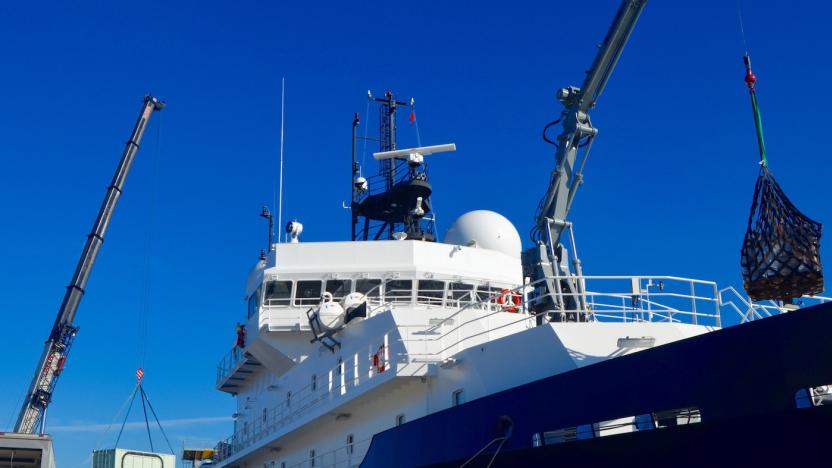oceanography
Latest

Hitting the Books: Newfangled oceanographers helped win WWII using marine science
Lethal Tides tells the story of pioneering oceanic researcher Mary Sears and her leading role in creating one of the most important intelligence gathering operations of World War II.

Almost a fifth of Earth's ocean floor has been mapped
Scientists have mapped nearly a fifth of the Earth's ocean floor, taking a big step forward for everything from biological studies to internet access.

Drones and RC kayaks offer fresh views of the ocean
The Scripps Institution of Oceanography has gotten a few more tech upgrades. Scientists aboard research vessel Sally Ride recently tested a pair of drones and a remote control kayak in an effort to get different views and readings of their subjects.

Xprize offers $7 million for exploring the ocean floor
After years of focusing on moonshots and other lofty goals, the Xprize Foundation now hopes to inspire innovation in the opposite direction... in a very literal sense. Its new Shell Ocean Discovery Xprize is offering a total of $7 million in awards to teams that can deliver robotic exploration of sea floors as deep as 4,000m (13,123ft). The $4 million grand prize and a $1 million runner-up prize will go to the groups that deliver the sharpest maps on top of meeting baseline requirements for autonomy, depth and speed. The top 10 teams will split a $1 million milestone prize, while the National Oceanic and Atmospheric Administration is chipping in another $1 million for teams that spot objects through biological and chemical clues.

Someone in China has hacked the Woods Hole Institute
The Woods Hole Oceanographic Institution, one of America's premiere scientific research centers, was reportedly hacked last June by unidentified forces operating in China. According to a staff letter sent by WHOI President and Director Mark Abbott this week, the institute has so far found that only emails and commercial data have been tampered with. While the WHOI does a lot of classified research for the US Navy, an institute spokesman points out that sensitive data is stored on a network separate from the one that was attacked.

Oceanographers invent device that tracks even the tiniest jellyfish
With barely two percent of the seafloor explored, we know a whole lot less than we'd like to about the Earth's oceans and its myriad of residents. Among the more numerous but less studied oceanic animals are soft-bodied like squid, octopi and jellyfish. However thanks to a new tracking tag technology developed at the Woods Hole Oceanic Institute, marine biologists will be able to observe these delicate denizens of the deep as they never have before.

SeaOrbiter to begin construction by year's end, project price tag clocks in at $52.7 million
Remember that USS Enterprise-esque ocean research vessel we first ran across back in 2005? Yes, the one that was originally slated to hit the open waters in 2008 or 2009. After catching heat for its lofty ambitions for the last 12 years, the SeaOrbiter is finally set to begin construction later this year. The ship is slated to measure 170 feet (51 meters) tall, but to stabilize the vessel over half of the vehicle would stay below the surface, providing all sorts of collection systems and useful tools. Not only does it look like something out of Minority Report, but the SeaOrbiter is 100% sustainable. The ship's power is set to come from solar, wind and wave power with biofuel in case nature doesn't cooperate -- when the vessel isn't adrift via ocean currents. Funding has been obtained for the $52.7 million undertaking, which will produce an endless amount of data on global warming and marine biology around the globe. For a look at some renders of the massive vehicle, click though the gallery below for a quick peek. %Gallery-158595%

NASA's robot submarine achieves perpetual motion, of a sort
The Sounding Oceanographic Lagrangrian Observer Thermal Recharging (SOLO-TREC) autonomous underwater vehicle is, well, quite a mouthful. It's also the first submarine that can run a sizable percentage of forever without requiring a charge. When the 183-pound buoy dives, cooler water temperature causes a liquid wax-like substance inside to solidify, squeezing out oil that drives a hydraulic generator; when it surfaces, the wax softens once again, ready for another round. Every dive produces 1.7 watt-hours of electricity, enough to power all the instruments, GPS and buoyancy-control pump on board. It's like a drinking bird that never runs out of water. Designed by NASA's Jet Propulsion Laboratory and Scripps researchers, the thermal engine is envisioned as an oceanography tool... but since the US Navy also has a finger in the pie, don't be surprised if it plays a minor role in the coming robot apocalypse as well.



